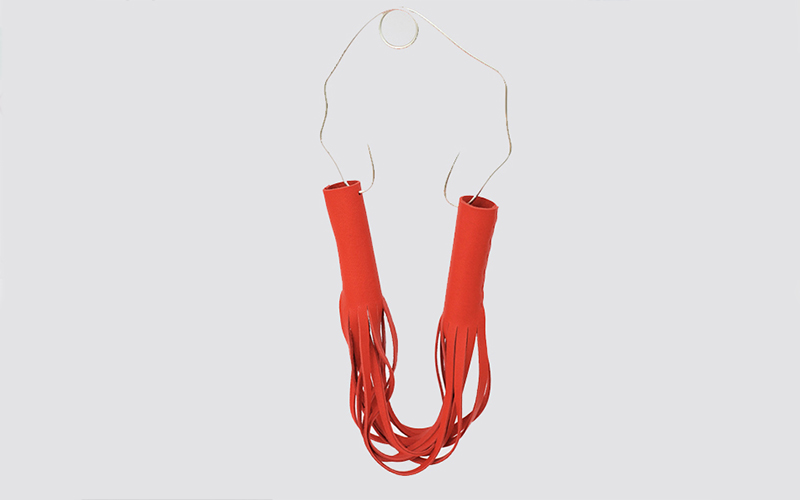Summer guests. Contemporary Jewellery in Portugal

This exhibition features works produced by artists such as Jorge Vieira, José Aurélio, Maria José Oliveira, Vítor Pomar and Pedro Calapez, all represented in the Modern Collection, alongside those that specifically marked the history of jewellery in Portugal from the 1960 onwards, including Kukas, Alberto Gordillo, Tereza Seabra and Alexandra de Serpa Pimentel. This exhibition extends throughout the Lalique Room in the Founder’s Collection with the dialogues therein established likely to cause surprise among visitors.
This is the third moment in Summer Guests, an initiative that proposes new readings of the permanent exhibitions in the Gulbenkian Museum and that was last year curated by the cineaste Joaquim Sapinho, who presented a pathway through the Modern Collection incorporating works and personal objects belonging to Calouste Gulbenkian.
In a short interview, the artist and researcher Cristina Filipe, curator of this edition, explained the concept at the origin of her project.
What is the general framework of your proposal?
Over the last decade, I was engaged in research on contemporary jewellery in Portugal (1963- 2004) at the Catholic University of Portugal and, for the last two years, out of 98 candidates from 24 countries, I was awarded the Susan Beech Mid-Career Artist Grant, from the Art Jewelry Forum (USA) for a project designed to produce a book reflecting on this research. Based on this context and within the same research scope, the Calouste Gulbenkian Foundation invited me to curate this third edition of the Summer Guests initiative seeking out relationships between contemporary jewellery and pieces in the Modern and René Lalique collections.
This proposal seeks to convey the ways in which contemporary jewellery accompanied the transformations taking place in arts while demarcating its field from those of the decorative and applied arts in which it had hitherto been integrated down through the history of art. Contemporary artists have highlighted the freedom with which Lalique presented pieces that were innovative within the context of the jewellery of his time and as one of the first such artists, dictating new norms and protocols that did not align with traditional jewellery.
Which artists are represented?
Artists from four different generations, born between 1925 and 1978, with various different backgrounds and with works developed across multiple fields but that make contemporary jewellery and in whose works I encountered, from different points of view, a relationship with the artists and works from the Modern and René Lalique collections.
What kind of relationships?
Chronological, symbolical, formal and conceptual relationships. Ranging from sculptors, painters or others who also included jewels in their works, some in more intimate fashions while others with more blatant declarations such as, for example, Maria José Oliveira (her first individual exhibition was entitled Textile Jewellery) through to artists whose jewellery pieces have never before gone on public display, such as Jorge Vieira, who exhibited his first work, a slate pendant, designed in the 1950s.
This saw the establishing of thematic and generational relationships, such as between Kukas and Escada, who lived in Paris in the late 1950s and beginning of the 1960s and became good friends and hence explaining some of the formal affinities in their works from this period. The same happened with Margarida Schimmelpfennig and Hein Semke, who lived together in the 1950s. Gordillo and Paula Rego, in turn, adopt an irreverent posture and oppositional politics with works by both of these artists rejected by their peers in the early phases of their careers. Furthermore, the carnation, a pendant by José Aurélio, and Streets of Lisbon, a collage by Ana Hatherly, represent the Portuguese revolution through graphical symbols.
There are also dialogues of an affective nature, such as that between Mário Freitas Ribeiro, founder of the Bristol Club in Lisbon and a patron of the modernists, and his daughter Alexandra Ribeiro, who made jewellery and whose works all disappeared in the wake of her death in 2013.
This intervention extends throughout the Lalique Room in the Founder’s Collection. What shall we discover in this room?
This led to the selection of two artists whose works evoke those of René Lalique: Alexandra de Serpa Pimentel and Catarina Silva. The former studied jewellery in the 1970s at the Central School of Art and Design in London where she produced three pieces interrelated with the work of Lalique not only in terms of the theme but also the forms and choices of materials.
The Snake and Dragonfly necklaces and the Snake bracelet, in silver and enamels, display a level of rigour and singular attention to detail. The work of Catarina Silva approximates that of Lalique in her colours and references to nature both in botanical terms and in the zoology dimension even while normally making recourse to non-precious metals and acrylic paints rather than enamels. For the three pendants in the exhibition, she opted for matt, bleached silver and thus formally reflecting, almost as if by radiographic design, the works of Lalique.
Know more